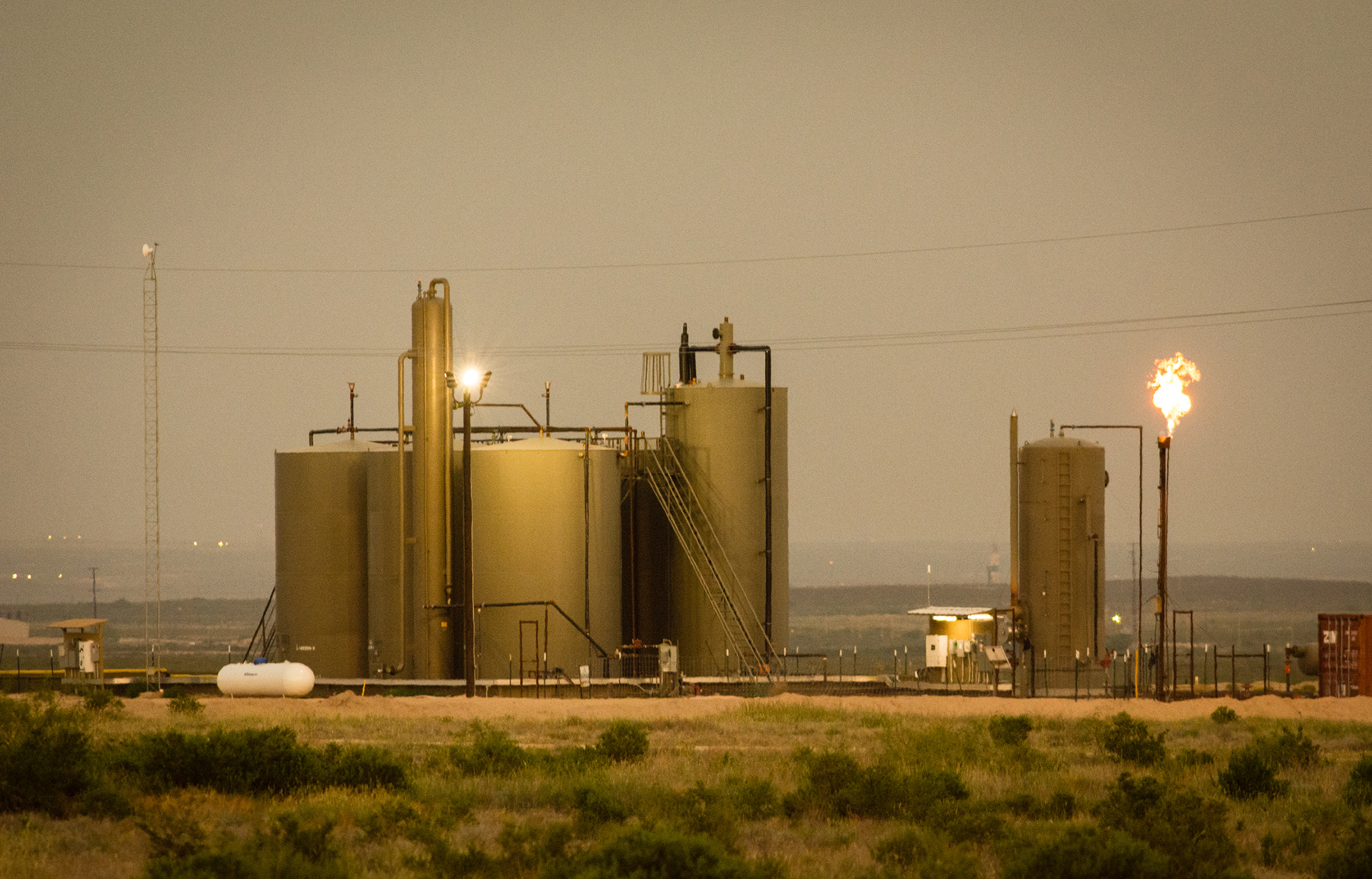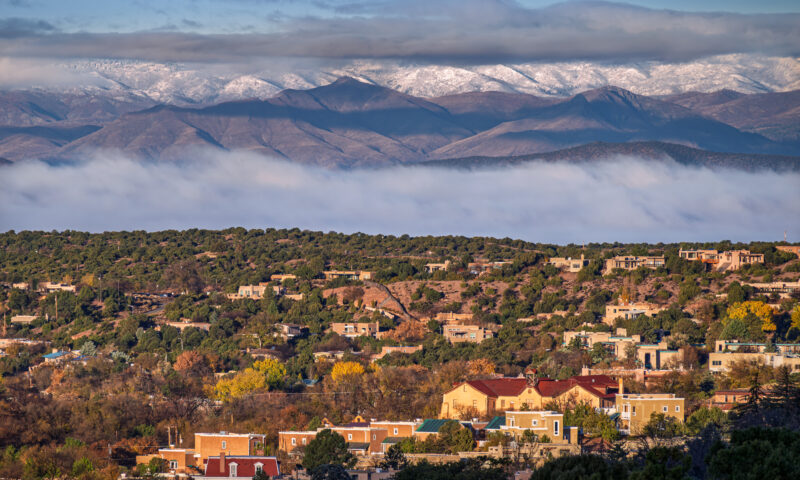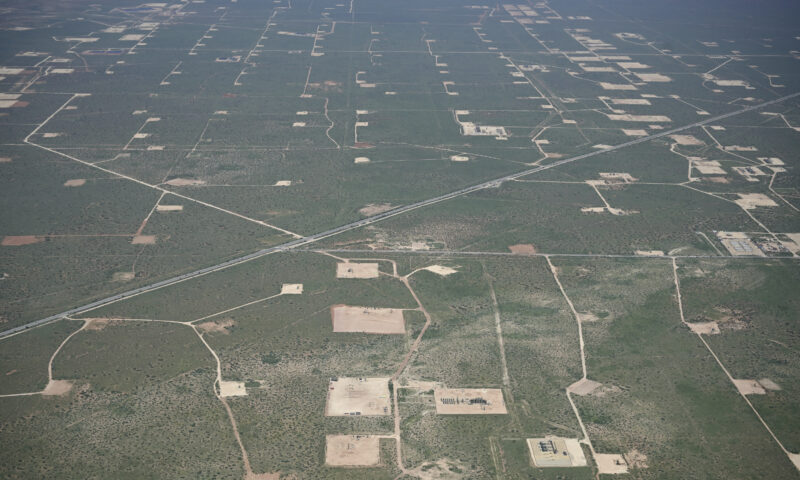States of Contention: The Biden Climate Package
‘Strongest Climate Bill Ever’ May Increase Oil and Gas Production in New Mexico
Biden’s methane reduction plan relies on historically weak enforcement.

This story is the first in a four-part series.
While President Joe Biden’s $737 billion Inflation Reduction Act (IRA) aims to address a cornucopia of American ills, arguably its most important aspect is how it jump-starts the country’s fight against climate change. It attacks the country’s carbon emissions from both ends — consumption and production — with one primary tool: money. A lot of money: $369 billion, to be exact, much of that devoted to helping people, companies and government agencies buy more things that create less carbon pollution. That has many activists hailing the bill as a historic step forward on climate action, but not everyone is sold on the strategy.
“All of these environmental organizations are singing its praise, ‘The strongest climate bill ever passed!’” says Sharon Wilson, a senior field advocate at Earthworks in Texas. “It is also the shittiest climate bill ever passed. Because it is the only climate bill that’s ever passed.”
Join our email list to get the stories that mainstream news is overlooking.
Sign up for Capital & Main’s newsletter.
There is only one climate punishment in the IRA: a new Methane Emissions Reduction Program (MERP) that levies a methane tax on oil and gas producers who exceed strict limits on how much they can emit the potent greenhouse gas. But the program may have the ironic consequence of increasing oil and gas production — and methane emissions — in New Mexico.
The MERP allows Environmental Protection Agency (EPA) administrators to use and enforce state rules when they meet or exceed what is written in the federal regulations. And since New Mexico already has some of the strictest oil field emissions regulations in the country, companies may choose to expand operations there with the clear, well-known regulatory system that is already in place, one that is likely to get a nod from the EPA.
But there’s also another, more practical reason why producers may want to go there: While the state has the rules, it hasn’t matched those rules with an increase in oil field monitoring and enforcement, and historically, the EPA hasn’t been a strong enforcer, either.
Reducing emissions from the consumer end will certainly, eventually, reduce greenhouse gas levels overall. Yet reducing production-side emissions — which are primarily composed of methane — could have a larger, quicker effect on lowering the country’s greenhouse emissions. As the International Energy Agency wrote earlier this year, “Methane emissions from oil and gas operations must be the first to go.” That’s because methane — the main component of natural gas — is more than 80 times more potent than carbon dioxide as a heat-trapping greenhouse gas.
“No state methane rules are effective, from what we’ve seen.”
~ Sharon Wilson, senior field advocate, Earthworks
In New Mexico, 53% of greenhouse gas emissions come from the oil and gas production sector, and the state has implemented two sets of rules in the past 15 months to bring those emissions down. State agencies like to say that they are the strongest methane reduction rules in the country. In fact, the state is “unique in getting ahead of the ball on methane,” says Barry Rabe, the J. Ira and Nicki Harris Family Professor of Public Policy and a professor of environmental policy at the University of Michigan. “Strategically, New Mexico could do very well on this under this legislation.” Many environmental groups hold similar hopeful views.
Wilson is less optimistic. For years, she has traveled through oil and gas fields across Texas, New Mexico and Colorado, thermal imaging camera in hand, documenting methane and other toxic gas leaks from petroleum production equipment. “There must be some assumption,” she says, “that the state methane rules will be effective.” But over the years, Wilson has found little evidence to support that.
“No state methane rules are effective, from what we’ve seen,” she says. “And from what the people who live near oil and gas tell us, they’ve not made a difference.”
And one federal agency has already begun the process of increasing oil and gas production in New Mexico under the IRA.
Infrared video shows fugitive emissions at a natural gas compressor station earlier this year in Eddy County, New Mexico. Video by Sharon Wilson of Earthworks.
* * *
New Mexico is particularly well prepared to rake in IRA cash for carbon reduction programs, thanks to recent policies set forth by Gov. Michelle Lujan Grisham.
IRA money for electric cars? New Mexico already has plans.
IRA money for wind and solar energy? New Mexico already has plans.
IRA money for clean hydrogen? New Mexico already has plans.
“There will be winners and losers in this [IRA], and I would think New Mexico could be well positioned to be a winner,” says Rabe, “because the state was proactive for many years.”
Fossil fuel-funded politicians were active as well. Buried within the IRA is a clause requiring that up to 2 million acres of federal land be opened to oil and gas production per year for the next decade if any federal acreage is set aside for renewable energy projects like wind and solar. It’s a ransom clause inserted to get those fossil fuel-friendly politicians to sign off on the bill. New Mexico is the country’s second-largest oil producer and eighth-largest natural gas producer, and much of that is done on federal lands. And unlike the country’s largest oil and gas producer — Texas — New Mexico has unleased federal land in the Permian Basin, the world’s most productive oil field.
“The IRA is going to make it a hell of a lot easier for the Interior Department to offer up more leases in the region,” says Jeremy Nichols, the climate and energy program director for WildEarth Guardians.
The promise of a new oil play in the lands surrounding Chaco Culture National Historical Park has divided the local Navajo community.
In fact, that began on October 6, when the Bureau of Land Management announced the first set of lease sales under this clause, offering — among other things — 19 parcels totaling 3,279 acres of federal land for drilling around the Permian.
“There are a lot of little leases in the Permian Basin that the industry has been gunning for,” says Nichols. The new Permian acreage allows companies to connect disparate plots of land and combine mineral rights, allowing easier drilling, he says.
“It’s not state-specific,” says a representative from U.S. Senator Martin Heinrich’s office. “The oil and gas acreage could all be in Wyoming or Alaska.” That’s true. The agency advertised leases in the Gulf of Mexico, and on federal land in Wyoming and Kansas as well (the Kansas acreage wasn’t in the BLM announcement but appears in its online files).
Nichols worries that future leases could be in the culturally sacred Greater Chaco region of northwestern New Mexico. Ancient ruins and roads spread across a landscape that’s already freckled with oil and gas wells, and the promise of a new oil play in the lands surrounding Chaco Culture National Historical Park has divided the local Navajo community. Plus, the area is a checkerboard of private, tribal and federal lands. Mario Atencio, a Navajo who works with the environmental protection group Diné CARE, worries about the possibility of new drilling around Chaco, something he’s fought against for years. “We don’t have a really in-depth analysis of what’s happening,” with the IRA, he says. “It’s being shotgunned, and we can’t find all the pellets all at once.”
Heinrich’s representative points out that “there’s no need for leasing to happen near Chaco in order to meet the requirements of the bill.” But there’s nothing in the bill to keep that from happening, either. In fact, that’s the kind of protection that Atencio and others have been hoping for since Biden took office. “It’s the administration trying to get a political win,” Atencio says, “and it’s a rough thing.”
* * *
Among the billions in the IRA, MERP offers $1.5 billion to oil and gas producers, doled out in two tranches through the EPA, as financial help and encouragement for monitoring and technical assistance to clean up everything in the production chain to keep it from leaking methane. Wilson understands the thinking behind the framework, but she still finds it irksome. “The government handing out more money to the oil and gas industry?” she asks. “It’s super-irritating that we’re having to give them more money when they are making record profits.”
Beyond monetary incentives, MERP also has a system of fines for emitted methane over set limits, starting at $900 per ton of excess emissions in 2024 and rising to $1,500 per ton in 2026. That fine covers releases from wells, pipelines and other oil field and transport equipment. Or it should — sometime in the next couple of years. MERP is really just one part of a larger federal methane reduction strategy, the other part being the EPA’s still-percolating methane rules, designed to account for and demand reductions of all oil and gas production emissions. MERP will be both the carrot ($1.5 billion) and the stick (fines by the ton) that keep producers in line with the rules. Once the EPA rules are passed, states can either default to them or write their own that must be at least as robust, as New Mexico has already done. That’s why Rabe thinks companies may spin more work in the state’s direction. New Mexico’s rules are a known quantity, and companies are already working with them.
New Mexico has roughly a dozen inspectors to monitor more than 53,000 active oil and gas wells across the state.
Even so, if history is a guide, when the EPA rules are finally announced and written into the agency’s code, conservative, petroleum-producing states may sue, which could drag out implementation of the plan just when such plans need to speed up. The American Petroleum Institute, this country’s biggest oil and gas industry group, has come out strongly against the proposed EPA rules and the IRA. In New Mexico, the New Mexico Oil & Gas Association has reprinted newspaper columns equally dismissive of the federal acts. (NMOGA did not respond to questions about how the IRA appears to favor oil and gas producers and set aside large chunks of money to help them.) It’s not clear how a conservative federal court system, shaped by years of Republican appointees, would rule if states were to sue.
Regardless of the outcome, such a case could postpone implementation of the whole plan, but time is of the essence. In the past year, a steady drumbeat of climate-charged weather catastrophes punctuated a stream of unnerving climate studies. The latest major study, published in Science, says that the planet is on the brink of five separate, disastrous climate tipping points, beyond which some biomes and regions simply will not recover. Adding an exclamation point to that study, scientists involved in writing the 2012 Intergovernmental Panel on Climate Change report pointed out recently that everything they predicted 10 years ago has come to pass, from heat waves to flash floods to increasing hurricanes.
And finally, there’s always the specter of failure. The MERP program simply might not work. The program relies on companies to monitor themselves and report their emissions (that’s what the $1.5 billion is meant to help with), and it relies on states or the EPA to enforce the rules. Neither of those two things has a strong history of success — especially in New Mexico.
* * *
For years, New Mexico Environment Secretary James Kenney has led the charge for more people and funding for the state’s main environmental agency. At the Oil Conservation Division, Director Adrienne Sandoval has done the same. In neither case has the state government come close to matching the requests, leaving roughly a dozen inspectors between the two agencies to monitor more than 53,000 active oil and gas wells across the state. And it’s not just inspectors. Both offices also have requested lawyers and office staff to build cases and prosecute scofflaws in the oil and gas fields — to no avail.
As for the EPA, in 2019, Kenney invited the agency to conduct flyovers in New Mexico, looking for significant, unreported emissions from oil field equipment. A Capital & Main report on the program’s meager results in light of finding hundreds of leaking wells led Kenney and Sen. Heinrich’s office to demand that the EPA explain why there weren’t more prosecutions.
Sharon Wilson, the advocate at Earthworks, dismisses the idea of companies reliably reporting on themselves. “It’s like getting drunk, driving home, then calling the cops to give you a ticket,” she says. In other words, MERP fines give companies a strong incentive to inaccurately report what they are emitting.
Studies from the Environmental Defense Fund (EDF) and others drive the point home: In the field, producers emit far more greenhouse gasses than they admit, or even realize. A recent study published in Science found that natural gas flares in the three oil and gas basins responsible for more than 80% of the country’s flaring — the Permian, Eagle Ford and Bakken — do not burn natural gas as efficiently as previously assumed. And the Permian Basin had the least effective flares of the three, with an observed methane burning efficiency of 89% — well below the other two, and far below the previously assumed efficiency of 98% for flares. Many of the other assumptions that the EPA uses to model likely pollution are 30 years old and badly out of date too, says Jon Goldstein, the senior director of regulatory and legislative affairs at EDF.
Still, he holds a more hopeful view of the IRA, MERP and the upcoming EPA methane rules than Wilson does. Goldstein notes that some large energy producers publicly back reducing methane emissions, and a number of them also helped craft New Mexico’s own methane reduction rules. “I think there is an excellent opportunity for the Biden administration to get a plan in place that meets its methane emissions reduction goals,” he says, “but it will hinge on the strength and comprehensiveness of the EPA oil and gas methane rules.”
Goldstein will be looking for regular inspections of smaller, leak-prone wells, the end of routine gas flaring, and an end to leaky pneumatic controllers on wells and other equipment, among other things. And all of that needs to happen very quickly, he says.
“We are eagerly awaiting the EPA proposal this fall,” Goldstein says.
For years, depending on the political party in power, states and the federal government have tried to rein in the oil and gas industry and reduce its pollution and climate-changing emissions. The combination of the IRA’s MERP and the upcoming EPA rules might be the one-two punch that brings New Mexico’s biggest industry and one of the world’s most potent polluters to heel.
“And ‘might’ is an important word,” Wilson says. “I think a lot of people are confused about how much difference this bill might make … because it might not make much difference at all.”
Copyright 2022 Capital & Main

-

 StrandedNovember 25, 2025
StrandedNovember 25, 2025‘I’m Lost in This Country’: Non-Mexicans Living Undocumented After Deportation to Mexico
-

 Column - State of InequalityNovember 28, 2025
Column - State of InequalityNovember 28, 2025Santa Fe’s Plan for a Real Minimum Wage Offers Lessons for Costly California
-

 The SlickNovember 24, 2025
The SlickNovember 24, 2025California Endures Whipsaw Climate Extremes as Federal Support Withers
-

 Striking BackDecember 4, 2025
Striking BackDecember 4, 2025Home Care Workers Are Losing Minimum Wage Protections — and Fighting Back
-

 Latest NewsDecember 8, 2025
Latest NewsDecember 8, 2025This L.A. Museum Is Standing Up to Trump’s Whitewashing, Vowing to ‘Scrub Nothing’
-

 Latest NewsNovember 26, 2025
Latest NewsNovember 26, 2025Is the Solution to Hunger All Around Us in Fertile California?
-

 The SlickDecember 2, 2025
The SlickDecember 2, 2025Utility Asks New Mexico for ‘Zero Emission’ Status for Gas-Fired Power Plant
-

 Latest NewsDecember 1, 2025
Latest NewsDecember 1, 2025Accountable to No One: What 1990s L.A. Teaches Us About the Trump Resistance

